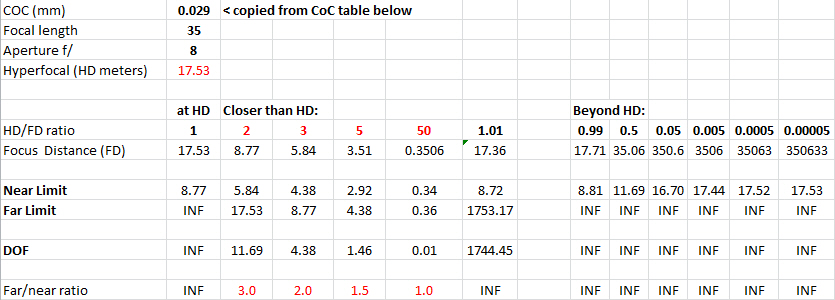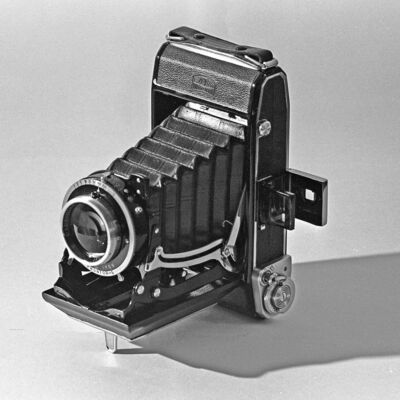Check out Digital Artistry section of our forum.
Wha'ts all this crop sensor DoF Stuff?
May 3, 2024 15:09:11 #
OldCADuser wrote:
that’s funny! And true.And as engineers, we also notice everything around... (show quote)
May 3, 2024 15:14:23 #
This question is for selmslie. I am seeing here the DOF calculators could be wrong. And shame on them for that.
Here is the question: How can we tell if the one we are using is wrong?
Here is the question: How can we tell if the one we are using is wrong?
May 3, 2024 15:37:24 #
JD750 wrote:
This question is for selmslie. I am seeing here the DOF calculators could be wrong. And shame on them for that.
Here is the question: How can we tell if the one we are using is wrong?
Here is the question: How can we tell if the one we are using is wrong?
I use hyper focal when I don't use the one third in rule. Now I wonder if it is good. It's always been good for me. Maybe it's only close.

May 3, 2024 16:09:40 #
frankraney wrote:
It's always good to be open to new ideas, but also you say 1/3 has been working and there is another saying which is "if it ain't broke don't fix it." LOL. I use hyper focal when I don't use the one third in rule. Now I wonder if it is good. It's always been good for me. Maybe it's only close.


Everyone has a process, nothing wrong with that. Myself I just look thru the viewfinder and use DOF Preview to evaluate the depth of focus.
May 3, 2024 16:25:37 #
JD750 wrote:
This question is for selmslie. I am seeing here the DOF calculators could be wrong. And shame on them for that.
Here is the question: How can we tell if the one we are using is wrong?
Here is the question: How can we tell if the one we are using is wrong?
Compare it to the one from Cambridge in Colour which has been thoroughly tested and documented before it was published.
But the numbers may not tell you anything useful if you are using a camera with a 1" sensor or smaller. That's so small that you can't see anything beyond the DOF (out of focus, OOF) unless your camera was very close to the subject and using a relatively long focal length and a very wide aperture.
A more extreme situation is when you use a smartphone which has an even smaller sensor. Despite the apparent wide fixed aperture, it's almost impossible to see the limits of the DOF. I showed this in https://www.uglyhedgehog.com/t-805958-11.html#14598145 along with a way to compare the iPhone to full frame camera.
Another factor with very small sensors is whether you are viewing the entire original (uncropped) image from a normal viewing distance (NVD) which is about the same as the image diagonal. You might only see OOF issues if you pixel peep, which artificially brings you much closer than the NVD, and there are a lot of MP in the original image (more than 8MP).
Anything posted online, especially when it's cropped or reduced in size, can be misleading - either out of ignorance or deliberate fraud.
May 3, 2024 16:46:57 #
JD750 wrote:
It's always good to be open to new ideas, but also you say 1/3 has been working and there is another saying which is "if it ain't broke don't fix it." LOL.
Everyone has a process, nothing wrong with that. Myself I just look thru the viewfinder and use DOF Preview to evaluate the depth of focus.
Everyone has a process, nothing wrong with that. Myself I just look thru the viewfinder and use DOF Preview to evaluate the depth of focus.
The DOF preview never really worked because you can't judge the DOF on your camera's LCD or in the viewfinder of an SLR/DSLR. It's even difficult to see on the ground glass of a medium or large format film camera.
The 1/3-2/3 (1:2 ratio) "rule" only applies when your camera is focused at 1/3 of the hyperfocal distance. As you focus closer, the ratio approaches 1:1 and eventually gets there at true macro distances.
At the hyperfocal distance (HD) the ratio is ∞:HD/2 making the DOF infinite.
And once you pass HD, the ratio becomes ∞:(something less than HD/2) but the DOF remains infinite.
Some lenses can focus a little past infinity which might vary with temperature to avoid a hard stop.
May 3, 2024 22:14:16 #
selmslie wrote:
And once you pass HD, the ratio becomes ∞:(something less than HD/2) but the DOF remains infinite.
That's not entirely correct. As you focus beyond HD, the DOF indeed remains infinite. But if you focus at infinity, the near limit of the DOF is at HD.
So the statement should read, "∞:(something greater than HD/2)". And the distance from HD to ∞ is ∞.
So it is not a mistake to focus at infinity if there is nothing of interest between the camera and HD.
Check out The Dynamics of Photographic Lighting section of our forum.
May 4, 2024 11:07:22 #
selmslie wrote:
That's not entirely correct. As you focus beyond HD, the DOF indeed remains infinite. But if you focus at infinity, the near limit of the DOF is at HD.
So the statement should read, "∞:(something greater than HD/2)". And the distance from HD to ∞ is ∞.
So it is not a mistake to focus at infinity if there is nothing of interest between the camera and HD.
So the statement should read, "∞:(something greater than HD/2)". And the distance from HD to ∞ is ∞.
So it is not a mistake to focus at infinity if there is nothing of interest between the camera and HD.
Here is some more information on the ratios of focal distance to HD and how they affect the distribution of DOF closer to and further from the focal distance. I have attached the spreadsheet if you want to explore how this works for your own camera.
The basic inputs are:
- the sensor's CoC (the spreadsheet includes a table with sensor sizes from a one inch sensor to 11x15" film.
- lens focal length
- aperture
That is used to calculate the hyperfocal distance.
The HD/FD ratio is 1 if you focus at HD, 2 at HD/2, 3 at HD/3, etc.
FD is calculated from the HD and the HD/FD ratio.
The near and far DOF limits and total DOF are then calculated.
Finally we see the ratios of the DOF beyond FD to DOF nearer to the camera than FD (Far/near ratio):
- Focused at HD, the ratio is infinite
- At 1/2 HD, the ratio is 3:1
- At 1/3 HD, the ratio is 2:1
- At 1/5 HD, the ratio is 1.5:1
- At 1/50 HD (close to macro), the ratio is 1:1
Those ratios are the same no matter what you enter for CoC, focal length or aperture.
If you focus beyond HD, the far/near ratio is always infinite. If you focus at infinity, the near limit for the DOF is always HD.
May 4, 2024 13:29:58 #
frankraney wrote:
I use hyper focal when I don't use the one third in rule. Now I wonder if it is good. It's always been good for me. Maybe it's only close.


Dont worry that "maybe its only close".
"Only close" is what DoF is all about.
Its about whats good enuf on either side of perfect. Despite formulae and CoC standards, "good enuf" is a subjective case-by-case call, and therefor a variable.
May 4, 2024 13:33:41 #
User ID wrote:
Dont worry that "maybe its only close".
"Only close" is what DoF is all about.
Its about whats good enuf on either side of perfect. Despite formulae and CoC standards, "good enuf" is a subjective case-by-case call, and therefor a variable.
"Only close" is what DoF is all about.
Its about whats good enuf on either side of perfect. Despite formulae and CoC standards, "good enuf" is a subjective case-by-case call, and therefor a variable.

May 4, 2024 14:39:31 #
User ID wrote:
Dont worry that "maybe its only close".
"Only close" is what DoF is all about.
"Only close" is what DoF is all about.
We can calculate until we are blue in the face but it all boils down to the classic definition of the circle of confusion (CoC), "The circle of confusion is a bunch of photographers arguing about the meaning of depth of field."
Aside from having to guess how good the viewer's eyesight is, the one thing we cannot control is how close they will get to view the image. And they will probably not even bother to get too close unless they run out of reasons to conclude that the image sucks.
Visual acuity factors

Check out The Dynamics of Photographic Lighting section of our forum.
May 4, 2024 14:50:32 #
selmslie wrote:
We can calculate until we are blue in the face but it all boils down to the classic definition of the circle of confusion (CoC), "The circle of confusion is a bunch of photographers arguing about the meaning of depth of field."



May 4, 2024 15:01:48 #
selmslie wrote:
Thank you. I have perused Cambridge in Color before I am familiar with them. I will check their DOF calculator. FYI My cameras are M43, FF and also 2.5" square (120 Film).Compare it to the one from url=https://www.cambri... (show quote)
May 4, 2024 16:13:34 #
If you use the same aperture, focus at same distance to have the same DOF the focal length of the crop camera is f and the focal length of the FF camera is F then
f= (F.√(crop factor))/(crop factor)
f= (F.√(crop factor))/(crop factor)
May 4, 2024 16:18:12 #
BebuLamar wrote:
If you use the same aperture, focus at same distance to have the same DOF the focal length of the crop camera is f and the focal length of the FF camera is F then
f= (F.√(crop factor))/(crop factor)
f= (F.√(crop factor))/(crop factor)
Then the f/stop must change.
If you want to reply, then register here. Registration is free and your account is created instantly, so you can post right away.
Check out Traditional Street and Architectural Photography section of our forum.







